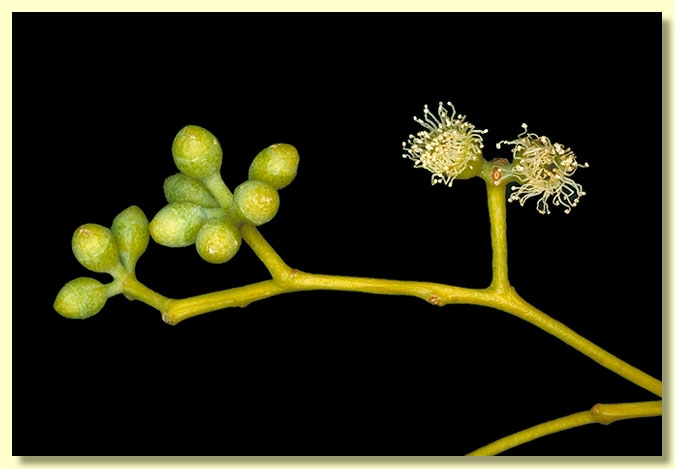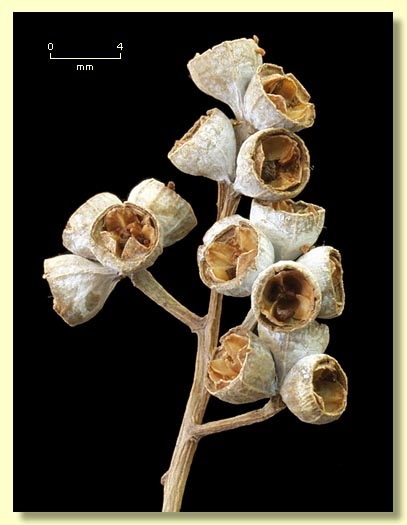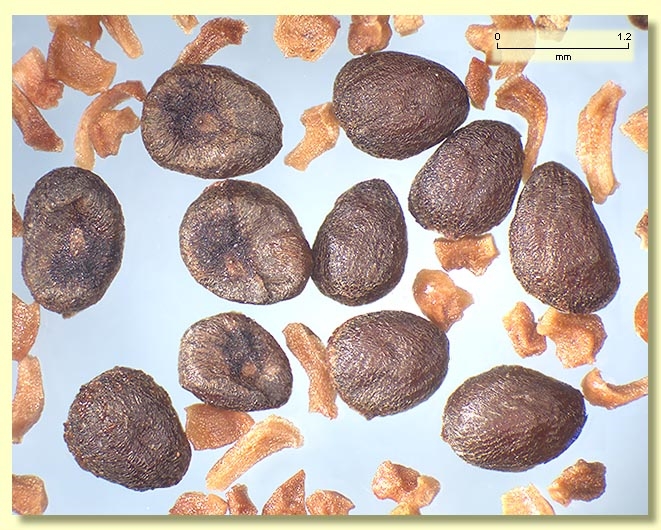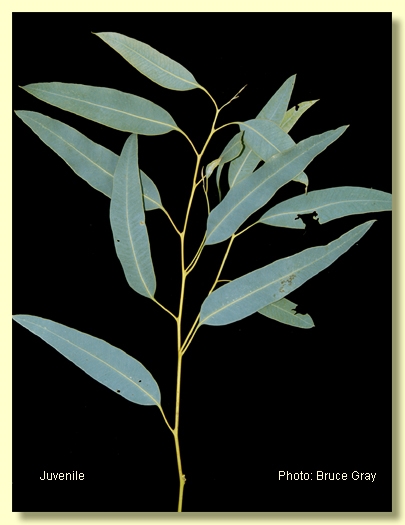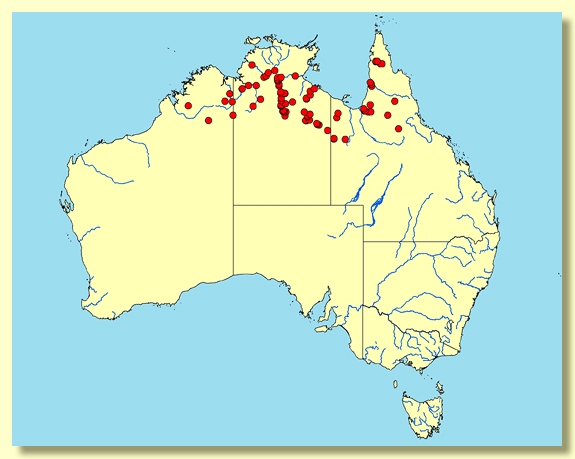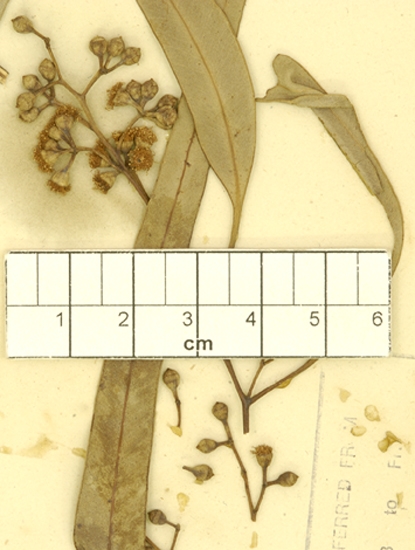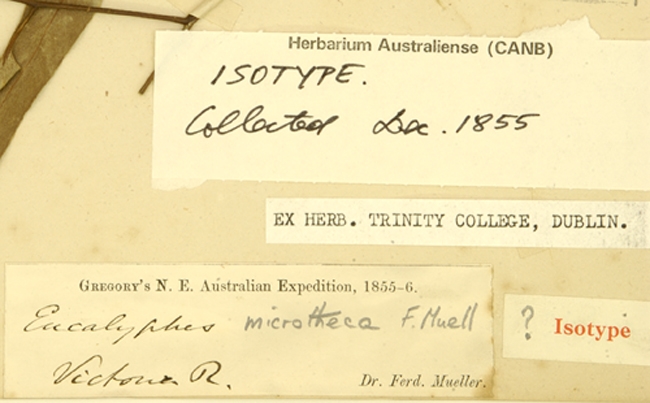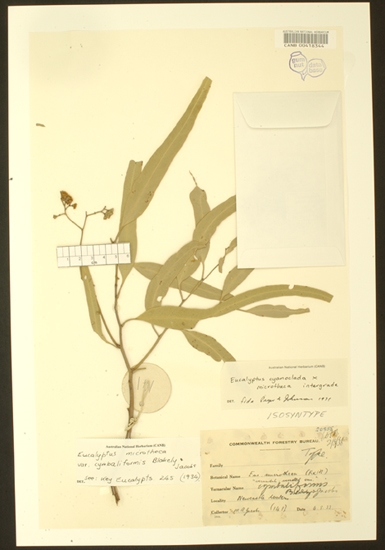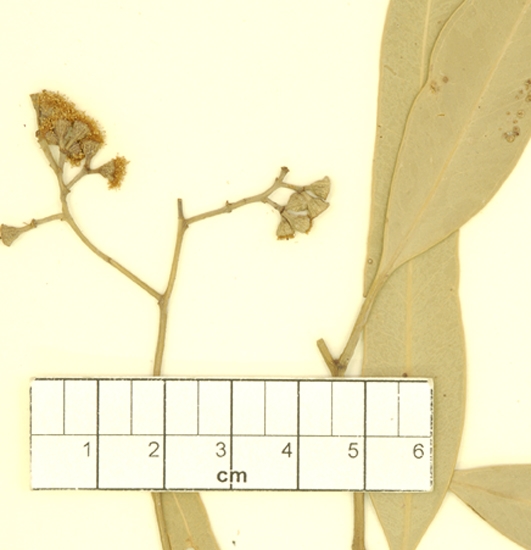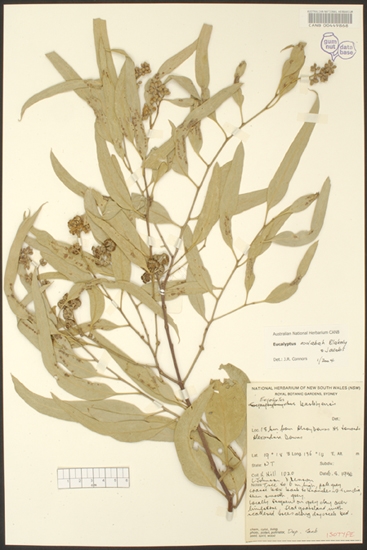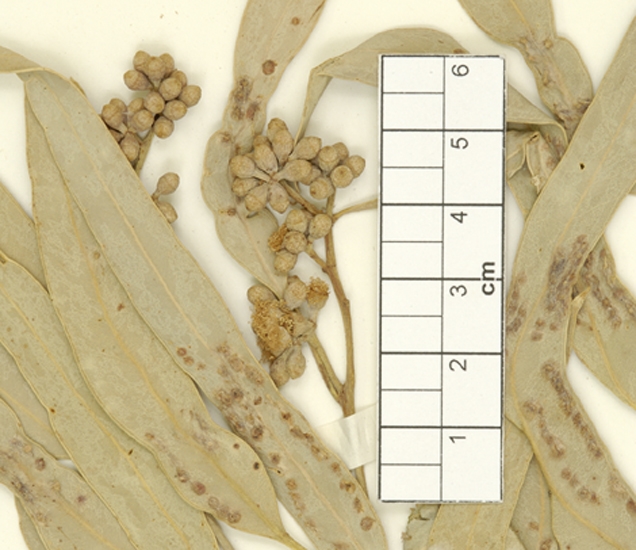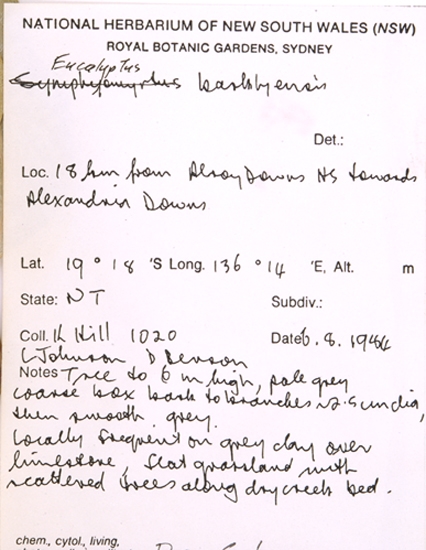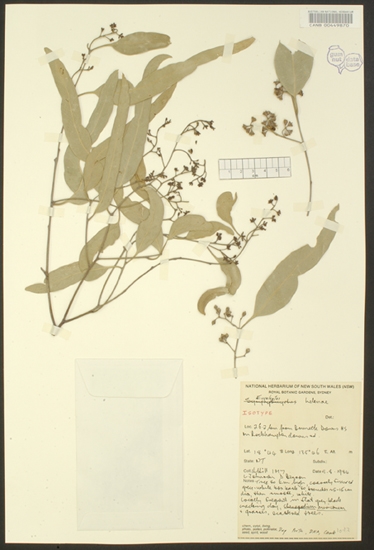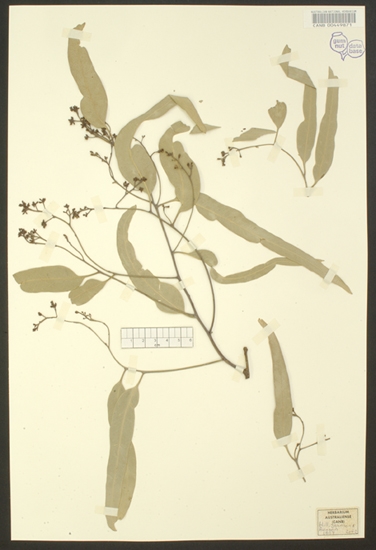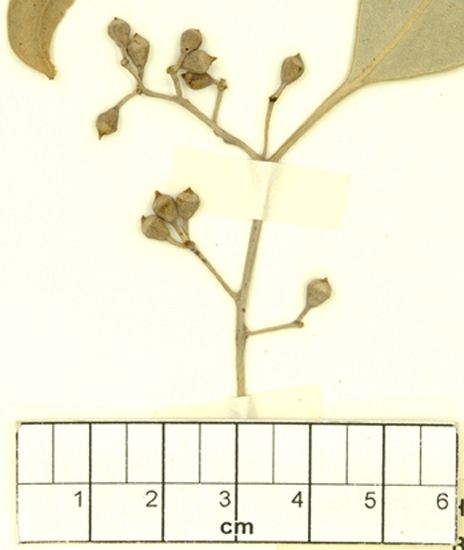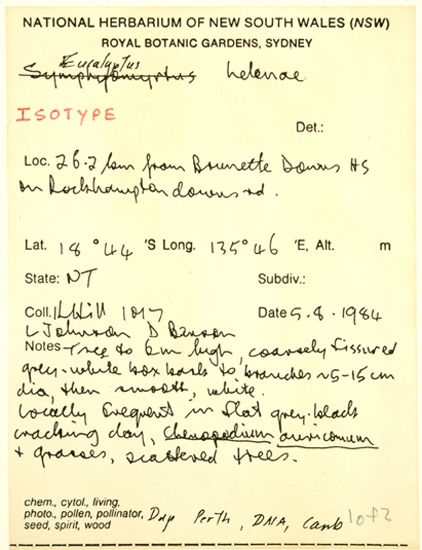Eucalyptus | Symphyomyrtus | Adnataria | Apicales | Aquilonares | Protrusae
Euclid - Online edition
Eucalyptus microtheca
Eucalyptus cyanoclada Blakely, Key Eucalypts 242 (1934). T: Newcastle Waters, Northern Territory, Aug. 1922, C.E.F.Allan 636; holo: NSW; iso: BRI.
Eucalyptus microtheca var. cymbaliformis Blakely & Jacobs, in Blakely, Key Eucalypts 245 (1934). T: Newcastle Waters, Northern Territory, Aug. 1933, C.E.F.Allan & M.R.Jacobs 141; holo: NSW; iso: CANB.
Tree to 10 m tall, rarely more, or sometimes a mallee. Forming a lignotuber.
Bark rough, whitish grey to dark grey, box-type, often deeply fissured, coarsely flaky or becoming tessellated, the branches commonly rough-barked though this feature is variable.
Branchlets lacking oil glands in the pith; usually non-glaucous, rarely glaucous.
Juvenile growth (coppice or field seedlings to 50 cm): stems rounded to square in cross-section, usually non-glaucous; juvenile leaves always petiolate, opposite for a variable number of nodes then alternate, narrowly lanceolate, 5–15 cm long, (0.3)0.5–2.5 cm wide, apex rounded or pointed, bluish green to green.
Adult leaves alternate, petioles 0.6–2 cm long; blade lanceolate to falcate, 5–19.5 cm long, 0.6–3(4.5) cm wide, base tapering to petiole, apex pointed or rounded, margin entire, concolorous, dull, green to blue-green or rarely glaucous, side-veins acute or at a wider angle to the mid-rib, reticulation very dense, intramarginal vein present, oil glands sparse, intersectional, or obscure.
Inflorescence terminal compound, peduncles slender, 0.2–0.9(1.2) cm long, buds in 7s but umbels are sometimes irregular due to short internode elongation within the cluster, pedicels 0.1–0.3 cm long. Mature buds pyriform to obovoid or globular, 0.3–0.4 cm long, 0.2–0.3 cm wide, non-glaucous or glaucous, scar present (outer operculum lost early), operculum rounded and apiculate, rarely conical, stamens irregularly flexed, all fertile, anthers adnate, cuboid, dehiscing by lateral slits, style long, straight, stigma blunt, locules 3 or 4, the placentae each with 4 vertical ovule rows. Flowers white.
Fruit on pedicel 0.1–0.3 cm long or, rarely, subsessile, truncate-globose to obconical, usually contracted at the top, 0.2–0.5 cm long, 0.3–0.7 cm wide, glaucous or non-glaucous, rim thin, rarely flared, disc descending vertically, narrow, valves 3 or 4, near rim level or barely exserted.
Seeds dark brown, 1–2 mm long, flattened-ovoid, dorsal surface smooth, hilum ventral.
Cultivated seedlings (measured at ca node 10): cotyledons reniform; stems rounded or square in cross-section; leaves always petiolate, opposite for ca 4 to 10 nodes then becoming alternate, lanceolate to narrowly so, 6–10.5 cm long, 0.5–1.5 cm wide, base tapering, apex rounded or pointed, blue-green to grey-green or green.
Flowering has been recorded in January, September, November and December.
A tree of widespread distribution in northern Australia, found fringing seasonally dry watercourses, swamps, lakes and low-lying areas subject to temporary inundation. It occurs east from the Ord River in the Kimberley region of Western Australia through the Northern Territory north from about Newcastle Waters and including the Barkly Tableland (but see below), to the Roper River and Macarthur River, extending into the Gulf country of Queensland as far east as western Cape York and as far south as near Mount Isa and Chillagoe.Eucalyptus microtheca usually has rough bark over the whole trunk extending to the branches and a crown of dull green, grey-green or sometimes glaucous leaves and small fragile fruit with valves at rim level (not prominently exserted) when dehisced.
Eucalyptus microtheca is most closely related to the widespread E. coolabah, which is found in similar but drier habitats to the south and south-east, and to E. victrix, which occurs in still drier habitats from central Australia west to the Pilbara. E. coolabah has rough bark on part or all of the trunk, having whitish smooth bark on the branches, and has conspicuously exserted valves in the otherwise shallower hemispherical-obconical fruit. E. victrix has smooth powdery white bark and similar fruit to E. microtheca with valves at rim level or slightly exserted. E. microtheca is also closely related to E. tectifica, both species having rough bark to the small branches. E. tectifica and E. microtheca are easily separated by comparing the shape and dimensions of their juvenile leaves, E. microtheca usually being narrowly lanceolate and E. tectifica normally ovate to broadly lanceolate. The fruit of E. tectifica also tend to be slightly wider and usually longer than those of E. microtheca but some overlap in these dimensions does occur. Another closely related member of this group is E. acroleuca from Cape York Peninsula. E. acroleuca differs by having basal rough bark with a fairly regular "cut-off" about halfway up the trunk and conspicuous smooth bark on the upper trunk and branches, and very small fruit (0.2–0.3 cm wide only) with enclosed valves.
Several localised forms of species in this "coolibah" group have been described—E. cyanoclada, a blue-leaved more or less glaucous form occurring around Lake Woods and Newcastle Waters in the Northern Territory; E. barklyensis with smooth smaller branches, thicker leaves and more spreading form than E. microtheca, restricted to the Barkly Tableland in the Northern Territory; and E. helenae, described from the south-western Barkly Tableland, differing in having marginally larger fruit with a slightly flared top and a broader disc, smooth branches and thicker and sometimes wider leaves than E. microtheca. In EUCLID we take a broader view of E. microtheca, including E. cyanoclada, E. barklyensis, E. helenae within it. The taxonomy of the group is complicated by E. microtheca, E. coolabah and E. victrix having adjoining distributions and showing intergradation in form. To make reliable identification collectors will need to note the extent of rough bark and ensure collection of mature fruit. E. microtheca and related species flower in late spring and early summer, quickly ripen their fruit and shed seed over the following few months. The fruit are on slender pedicels and peduncles and are soon lost from the trees. Even with mature fruit and the most careful observation of bark and leaves there will still be many individuals, especially on the Barkly Tableland, that don't fit neatly into any particular "coolibah" species. Populations of coolibahs may contain individuals all of which display distally contracted fruit (like E. microtheca, E. barklyensis and E. helenae) but which vary in bark persistence, from having some scrappy basal rough bark with the upper trunk and branches being smooth-barked, to being fully rough-barked to the smaller branches, and with all possibilities in between. Because of the variability in bark persistence and the seeming consistency of "microtheca-like" fruit shape we have chosen to synonymise E. barklyensis and E. helenae with E. microtheca rather than E. coolabah. However it would not surprise us if there were "coolibah" trees in this area that matched E. coolabah in fruit shape just to complicate the picture.
At the remote Lake Cohen in the Gibson Desert of Western Australia plants somewhat resembling the E. cyanoclada form of "coolibah" from Newcastle Waters—Beetaloo area having slightly larger fruit with valves enclosed but near rim level and being half rough-barked and with glaucous buds, fruit, branchlets and growth tips and bluish leaves. The identity of these is an unanswered question—the usual desert "coolibah" is E. victrix which differs in all these features whilst E. coolabah from Central Australia east of here differs markedly in fruit features. The Lake Cohen form requires further study.
Eucalyptus microtheca belongs in Eucalyptus subgenus Symphyomyrtus section Adnataria (the boxes) because the buds have two opercula, ovules are in four rows, seeds are flattened-ovoid, cotyledons are reniform, and anthers are rigid on the staminal filaments. Within section Adnataria, E. microtheca is part of a subgroup of box species with mostly tropical distribution, series Aquilonares subseries Protrusae, having inflorescences terminal on the branchlets, adult leaves very densely reticulate and fruit that are small, fragile and have exserted valves (according to Brooker (2000) other species in this subseries are: E. tectifica, E. coolabah, E. victrix, E. acroleuca, E. distans, E. obconica, E. microneura, E. argillacea, E. chlorophylla).
Eucalyptus microtheca: from Greek micro-, small and thece, a box, referring to the small fruit.




